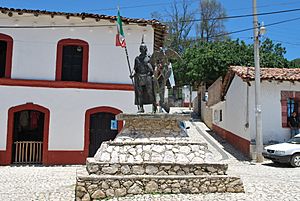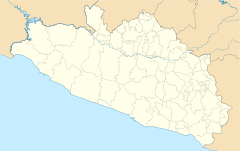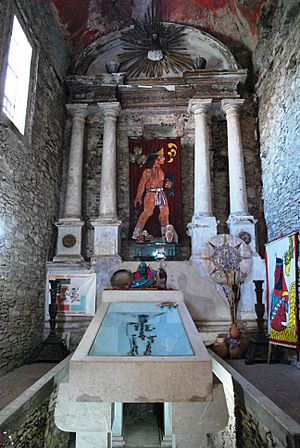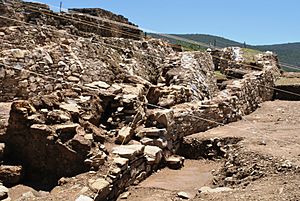Ixcateopan de Cuauhtémoc facts for kids
Quick facts for kids
Ixcateopan, Guerrero
|
|
|---|---|
| Ixcateopan de Cuauhtémoc | |

Monument to Cuauhtémoc in a plaza in the town
|
|
| Country | |
| State | Guerrero |
| Founded | 350 |
| Municipal Status | 1850 |
| Area | |
| • Total | 310.7 km2 (120.0 sq mi) |
| Elevation
(of seat)
|
2,600 m (8,500 ft) |
| Population
(2005) Municipality
|
|
| • Total | 6,104 |
| • Seat | 2,379 |
| Time zone | UTC-6 (Zona Centro) |
| Postal code (of seat) |
40430
|
Ixcateopan de Cuauhtémoc is a small town in the state of Guerrero, Mexico. It is nestled in rugged mountains. Many people believe it is the final resting place of Cuauhtémoc, the last Aztec emperor. His supposed remains were found under the local church in the mid-1900s.
The church is now a museum. It shows ancient artifacts and gifts left for the emperor. However, later research and a Mexican government commission in 1976 said the remains were not actually Cuauhtémoc's.
Ixcateopan de Cuauhtémoc is about 36 kilometers (22 miles) west of Taxco de Alarcón, a famous silver town. Unlike Taxco, Ixcateopan is surrounded by forests of pine, cedar, and walnut trees. A beautiful waterfall called Cascada de Cacalotenango is along the highway. It even has a small chapel at the top. The state capital, Chilpancingo, is 180 kilometers (112 miles) away.
The name Ixcateopan comes from the Nahuatl language. It combines "ichcacates" (or "ixcatle") meaning cotton, and "teopan" meaning temple. So, it often translates to "temple of cotton." Some believe the name changed to Ixcateopan after Cuauhtémoc's body arrived, meaning "here is the temple/church." The town's full name, "De Cuauhtémoc," was added in 1950 to honor the emperor.
Contents
History of Ixcateopan
Ancient Times and Aztec Rule
Long ago, before the Spanish arrived, groups like the Cohuixas and Chontals lived here. An ancient community existed on the town's southern edge as early as 350 C.E. This place was an important center for ceremonies and a base for soldiers. It was also known for making cotton products, which were very valuable.
Ixcateopan was one of the last cities the Aztec Empire conquered. It became a place where tribute (payments) from nearby areas were collected. Soldiers and people from other parts of the Aztec Empire came here because of wars with the Purépecha Empire. This made Ixcateopan, which was originally a Chontal city, a place where many cultures mixed.
The Mystery of Cuauhtémoc's Burial
Stories about Cuauhtémoc's death and burial were written by early Spanish missionaries. These writings ended up with the family of Salvador Rodriguez Juárez, a doctor in Ixcateopan in the early 1900s. The documents claimed Cuauhtémoc's body was brought to Ixcateopan in 1525. It was first buried at his grandparents' palace. Later, in 1529, it was moved to a spot where the Church of Santa María de la Asunción would be built. The documents said the tomb was almost directly under the church's main altar.
After Dr. Rodríguez Juárez shared these documents, the National Institute of Anthropology and History (INAH) sent an archaeologist, Eulalia Guzmán, to investigate. She looked at the documents, listened to local stories, and checked other historical clues. Based on this, they decided to dig where the documents said.
The Debate Over the Remains
The discovery of Cuauhtémoc's remains caused a big stir. Other teams from INAH were sent to check if the find was real. Their findings were mixed. Some researchers doubted the age of the bones, the documents, and the artifacts found.
In 1976, a special commission looked at all the evidence. They concluded that the bones belonged to eight different people from different times. They also said that the young adult bones found could not have been Cuauhtémoc's. The commission also found that the documents that led to the discovery were not real and were made after 1917. So, they officially stated there was no scientific proof that the remains were Cuauhtémoc's.
Today, most archaeologists believe the burial was not real. However, many local people and cultural groups still believe it is genuine.
Exploring the Town of Ixcateopan
Ixcateopan is home to about 2,400 people. One unique thing about the town is that its streets are paved with white marble. Many walls around houses also use this beautiful stone. The town's buildings look similar to those in the larger town of Taxco, with white houses and red clay roofs.
Because of the story of Cuauhtémoc's tomb, Ixcateopan has become a place of national interest in Mexico. On February 28th, the anniversary of Cuauhtémoc's death, flags fly at half-mast. The town attracts archaeologists, anthropologists, and historians who are interested in its history and ongoing discoveries.
Museum of Santa María de la Asunción
The Museum of Santa María de la Asunción is just south of the town's main plaza. It was a church from the 1500s until the mid-1900s. Then, it became a national monument. After the supposed tomb of Cuauhtémoc was found, the building changed from a religious place to a historical one.
Most of its Christian art was removed. Where the main altar once stood, there is now a special shrine to the last Aztec emperor. His alleged remains are on display. A small museum is in what used to be the church's extra room. Jairo Rodríguez, the son of the doctor who made the tomb documents public, is the official historian of Ixcateopan and looks after the museum.
Annual Ceremony for Cuauhtémoc
Cuauhtémoc is a powerful symbol of Mexican culture and identity. Many dancers and people from indigenous groups across Mexico and other American countries come here to celebrate him. The end of February is important because it marks Cuauhtémoc's birthday (February 23) and death (February 28).
His birthday draws the most dance groups. They come from all over Mexico, the U.S., Canada, and South America. They bring offerings, dance, and sing in many different languages. For several days around his birthday, dances and ceremonies happen almost non-stop. They use Aztec drums (huehuetls), wind instruments made from animal horns and conch shells, and burn copal incense.
Ixcateopan's Archaeological Zone
South of the Santa María de la Asunción Museum is the archaeological zone of Ixcateopan. This ancient site dates back to between 350 and 1450 C.E. It had at least five building stages. Even though construction stopped around 1450, people lived here until the Spanish arrived in 1521.
The archaeological zone covers about 5,000 square meters (about 1.24 acres). It has buildings on a natural hill. Builders used local materials like flagstone, limestone, marble, and smooth pebbles. These were covered in stucco and painted. This excavated area was used for religious ceremonies, managing the community, and for the local leaders to connect with other parts of the world. It was a very important religious site for the region.
Ixcateopan was a Chontal settlement that the Aztecs later conquered. This site has taught us a lot about the northern part of Guerrero state in ancient times. Groups like the Matlatzincas, Tepoztecos, Nahuas, and Chontales lived there.
Archaeologists first started digging here in 1976. More recent digs in the mid-2000s found new things. These include a set of stairs, homes, storage areas, and workshops. The pottery found shows influences from Aztec and Cholulteca cultures, as well as unique local designs. These finds help us understand how these ancient people lived and interacted with other groups. Most of the digging has been along an east-west line, exploring about 3,000 square meters. Efforts are being made to make Ixcateopan an "archaeological monuments zone" and get more money to continue the excavations.
See also
 In Spanish: Ixcateopan de Cuauhtémoc para niños
In Spanish: Ixcateopan de Cuauhtémoc para niños





